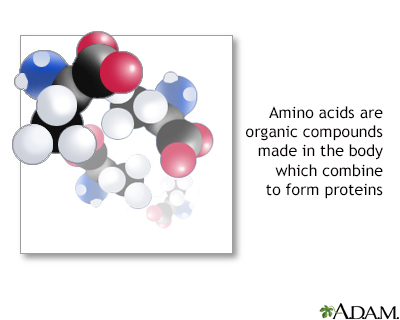Plasma amino acids
Definition
Plasma amino acids is a screening test done on infants that looks at the amounts of amino acids in the blood. Amino acids are the building blocks for proteins in the body.
Alternative Names
Amino acids blood test
How the Test is Performed
Most of the time, blood is drawn from a vein located on the inside of the elbow or the back of the hand.
In infants or young children, a sharp tool called a lancet may be used to puncture the skin.
- The blood collects in a small glass tube called a pipette, or onto a slide or test strip.
- A bandage is put over the spot to stop any bleeding.
The blood sample is sent to a lab. There are several types of methods used to determine the individual amino acid levels in the blood.
How to Prepare for the Test
The person having the test may be asked not to eat 4 hours before the test.
How the Test will Feel
There might be slight pain or a sting when the needle is inserted. You may also feel some throbbing at the site after the blood is drawn. The needle stick will probably cause an infant or child to cry.
Why the Test is Performed
This test is done to measure the level of amino acids in the blood.
An increased level of a particular amino acid is a sign of an irregularity. This shows that there is a problem with the body's ability to break down (metabolize) that amino acid.
The test may also be used to look for decreased levels of amino acids in the blood.
Increased or decreased levels of amino acids in the blood may occur with fevers, inadequate nutrition, and certain medical conditions.
Normal Results
All measurements are in micromoles per liter (µmol/L). Normal values may vary between different laboratories. Talk to your health care provider about your specific test results.
Alanine:
- Children: 200 to 450
- Adults: 230 to 510
Alpha-aminoadipic acid:
- Children: not detected
- Adults: not detected
Alpha-amino-N-butyric acid:
- Children: 8 to 37
- Adults: 15 to 41
Arginine:
- Children: 44 to 120
- Adults: 13 to 64
Asparagine:
- Children: 15 to 40
- Adults: 45 to 130
Aspartic acid:
- Children: 0 to 26
- Adults: 0 to 6
Beta-alanine:
- Children: 0 to 49
- Adults: 0 to 29
Beta-amino-isobutyric acid:
- Children: not detected
- Adults: not detected
Carnosine:
- Children: not detected
- Adults: not detected
Citrulline:
- Children: 16 to 32
- Adults: 16 to 55
Cystine:
- Children: 19 to 47
- Adults: 30 to 65
Glutamic acid:
- Children: 32 to 140
- Adults: 18 to 98
Glutamine:
- Children: 420 to 730
- Adults: 390 to 650
Glycine:
- Children: 110 to 240
- Adults: 170 to 330
Histidine:
- Children: 68 to 120
- Adults: 26 to 120
Hydroxyproline:
- Children: 0 to 5
- Adults: not detected
Isoleucine:
- Children: 37 to 140
- Adults: 42 to 100
Leucine:
- Children: 70 to 170
- Adults: 66 to 170
Lysine:
- Children: 120 to 290
- Adults: 150 to 220
Methionine:
- Children: 13 to 30
- Adults: 16 to 30
1-methylhistidine:
- Children: not detected
- Adults: not detected
3-methylhistidine:
- Children: 0 to 52
- Adults: 0 to 64
Ornithine:
- Children: 44 to 90
- Adults: 27 to 80
Phenylalanine:
- Children: 26 to 86
- Adults: 41 to 68
Phosphoserine:
- Children: 0 to 12
- Adults: 0 to 12
Phosphoethanolamine:
- Children: 0 to 12
- Adults: 0 to 55
Proline:
- Children: 130 to 290
- Adults: 110 to 360
Serine:
- Children: 93 to 150
- Adults: 56 to 140
Taurine:
- Children: 11 to 120
- Adults: 45 to 130
Threonine:
- Children: 67 to 150
- Adults: 92 to 240
Tyrosine:
- Children: 26 to 110
- Adults: 45 to 74
Valine:
- Children: 160 to 350
- Adults: 150 to 310
The examples above show the common measurements for results for these tests. Some laboratories use different measurements or may test different specimens.
What Abnormal Results Mean
An increase in the total level of amino acids in the blood may be due to:
- Eclampsia
- Inborn error of metabolism
- Fructose intolerance
- Ketoacidosis (from diabetes)
- Kidney failure
- Reye syndrome
- Laboratory error
A decrease in the total level of amino acids in the blood may be due to:
- Adrenal cortical hyperfunction
- Fever
- Hartnup disease
- Inborn error of metabolism
- Huntington chorea
- Malnutrition
- Nephrotic syndrome
- Phlebotomus fever
- Rheumatoid arthritis
- Laboratory error
High or low amounts of individual plasma amino acids must be considered with other information. Abnormal results may be due to diet, hereditary problems, or effects of a medicine.
Considerations
Screening infants for increased levels of amino acids can help detect problems with metabolism. Early treatment for these conditions may prevent complications in the future.
Gallery

References
Dietzen DJ, Vieira Willrich MA. Amino acids, peptides, and proteins. In: Rifai N, Chiu RWK, Young I, Burnham C-A D, Wittwer CT, eds. Tietz Textbook of Laboratory Medicine. 7th ed. St Louis, MO: Elsevier; 2023:chap 31.
Kliegman RM, St. Geme JW, Blum NJ, Shah SS, Tasker RC, Wilson KM. Defects in metabolism of amino acids. In: Kliegman RM, St. Geme JW, Blum NJ, Shah SS, Tasker RC, Wilson KM, eds. Nelson Textbook of Pediatrics. 21st ed. Philadelphia, PA: Elsevier; 2020:chap 103.
Riley RS, McPherson RA. Basic examination of urine. In: McPherson RA, Pincus MR, eds. Henry's Clinical Diagnosis and Management by Laboratory Methods. 24th ed. Elsevier; 2022:chap 29.